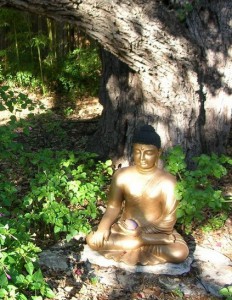Friday
Community ArticlesSurfing the Tides of Meditation in Austin
by Ian PowellSunday sitting practice at the Austin Shambhala Meditation Center (ASMC) comes together regularly based on the generosity and inspiration of individuals committed to developing bravery and gentleness through mindfulness-awareness meditation. On the path of meditation practice, one develops positive qualities by fully inhabiting one’s own life, and therefore supporting one’s community.
The format of a three-hour Sunday meditation session is firmly but gently prescribed: the staff arrive early and open the center, meditation cushions are set out or straightened up into a comfortable but orderly staggered grid pattern, and finally, the staff makes offerings of water, light, and pleasantly-scented incense to the shrine.
These simple and standard logistical facts of a regular Sunday meditation session are juxtaposed against the fertile possibilities that anyone could show up at any given time during the session to join the sit and that anything might come up for an individual practitioner during any given meditation session. The precise form of sitting practice combined with a space that can accommodate the openness of the human situation generates a powerful creative friction that characterizes and enriches meditation practice in an urban environment.
 Sunday sitting proceeds into the morning: beginning with voluntary, intention-orienting chants, and continuing with sitting meditation divided by short walking sessions. Throughout the morning, some newly-arriving meditators join the group and others bow out. Generally, by the end of the morning, the shrine room is filled with over 25 practitioners surfing (or sometimes doggy paddling, or other times wiping out) on the tides of meditative mindfulness-awareness.
Sunday sitting proceeds into the morning: beginning with voluntary, intention-orienting chants, and continuing with sitting meditation divided by short walking sessions. Throughout the morning, some newly-arriving meditators join the group and others bow out. Generally, by the end of the morning, the shrine room is filled with over 25 practitioners surfing (or sometimes doggy paddling, or other times wiping out) on the tides of meditative mindfulness-awareness.
Meditation instruction is freely offered at ASMC about an hour before sitting concludes. A rotating staff of meditation instructors offers first-time instruction to anyone who walks through the door looking slightly dazed. Common reasons that folks come to ASMC to receive meditation instruction include: curiosity about Buddhism, curiosity about meditation practice, seeking to gather material for a religious studies course, or sometimes, just being an inquisitive neighbor.
Around noon, the morning sit formally closes with chants of dedication—wishing that any openness of mind we experienced during our meditation session be of benefit to us, the people in our lives, and beyond. Initial meditation instruction concludes around noon as well. Little introductory literature packets are distributed to new meditators, containing meditation tips, info on upcoming classes, and a list of related books for those intellectually-inclined. New meditators are then invited to share tea snacks with the rest of the community.
Tea snack is where first-time meditators get to know the ASMC community. Tea snack is also an opportunity for the ASMC community to practice being together. This is where our mindfulness and awareness gets off the cushion and rises to a verbal, interactive level.An aside about meditation practice in general: One popular misconception about meditation practice is that the quality of one’s practice can be evaluated inversely proportional to how much thinking arises during a practice session. This idea would imply that the eventual goal of meditation is to enter a void, thoughtless state. However, that is not the point of meditation.
In meditation practice we learn how to set priorities. When we practice gently placing our mind on an object of our choosing, we are asserting a priority for our attention. When other requests for our attention arise — in the form of urgent or whimsical, electric or dull thoughts, we acknowledge these requests and gently return to the higher priority object of our attention.
In the Shambhala tradition, the breath is used as a basic object of attention — it is a natural part of us that is right there all the time and does not cost anything to enjoy. When thoughts arise during our practice, it is okay – they are just not the priority for what we are doing at that particular moment.
In a similar way, we can engage in community practice by placing genuine, kind, and wholesome interaction as our object of attention. When thoughts or insecurities or doubts about ourselves or others come up, that is not regarded as a bad thing, or as a thing to be avoided. It is just not the focus or priority of our practice.
Much as there is no need to indulge in utopian (or dystopian) visions about someday achieving a perfect individual meditation session, we neither need hope for someday-perfect community relations nor fear they will never arise. In this way, our community practice is focused on the present and available goodness and openness generated from actual human interaction.
Gradually, in the same way that we develop kindness toward ourselves and a stability of mind in our individual practice, we can also develop kindness toward others and a stability of shared intent through community practice.
Back at our Sunday ASMC tea snack, we have the opportunity to explore community practice both by seeing with fresh eyes and ears how we relate with others and by finding what dignity can arise from our genuine rapport. As the tea snack gathering begins to diminish, we can feel our social bonds renewed, taking perceived successes and failures, misses and connections, on or off the cushion, out into a broader world.
Without warning, we may find ourselves stopped briefly outside the ASMC door, noticing how radiant the afternoon sunlight looks, or catching a floral scent of particular pungency in the air. That moment of space and clarity to experience just how vibrant our sense perceptions can be is wonderful feedback that we are fully here, inhabiting our lives—holding the crisp, ephemeral moment joined with the residual hum of enjoying good and virtuous human community.
 ~~
~~
Ian Powell is an active volunteer at the vibrant and growing Austin Shambhala Meditation Center. An authorized meditation instructor in the Shambhala Buddhist tradition, Ian enjoys group discussion on how each of us can freshly connect with our own sense of inexhaustible wholesomeness.







Dec 29, 2011
Reply
“Without warning, we may find ourselves stopped…” by an article written by a sangha brother – wherein suddenly the commonplace becomes remarkable.
After three hours of sitting a cup of coffee acquires an allure that it normally doesn’t hold for me. And volunteers have come to provide this very thing, along with teas and fruits, pastries, dips and vegetables. Ah, the noon hour – with people, suddenly free to talk, commonly bonded in the shared experience of the struggles and joys of mind, and now in the world again.
Emaho! – the practice of Tea-Snack (Tibetan translation unknown)…